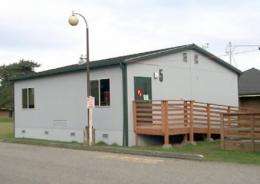Hidden Risks Of Modular Classrooms

Every school day, more than 5 million students in the United States attend lessons held in modular classrooms. With new carpeting and paint, metal roofs and noisy ventilation systems, they can be a health hazard and make it harder for students to learn.
Modular classrooms often start out as temporary fixtures on school grounds before becoming a permanent part of campus.
A study of all the modular classrooms in California found some common problems in these types of buildings. They are usually newer than the rest of the school's buildings, they tend to have new paint and carpet, which may release toxic fumes for a few years.
Because they are designed to be temporary, modular classrooms tend to develop structural problems such as water leaks or cracks faster than permanent school buildings and are more likely to be outfitted with pressed-wood furniture or vinyl walls which put out unhealthy fumes.
Scientists studying movable classrooms in California looked at dust from the floors and particles in the air inside the classrooms. The dust showed traces of pesticides, arsenic and mold, while the air contained formaldehyde fumes, heavy metals and higher than normal concentrations of pollen and carbon dioxide.
Norm Phillipp, a graduate student at University of Nebraska-Lincoln, studied how sound travels through portable classrooms in the Midwest and found that at each school at least one portable classroom was used for language instruction, students with special-needs, music instruction or for children younger than 8.
A survey of schools across the U.S. agreed, finding that 26 percent of modular classrooms are used as music rooms, 11 percent are used for early childhood programs, and 9 percent are used for language instruction. According to Phillipp, these are exactly the wrong ways for portable classrooms to be used.
"When I saw this, my jaw hit the floor," Phillipp said. "These types of usages should never be in a modular classroom. If any kinds of classrooms meet the [noise] standard, it has to be these."
Kids need a quieter environment than adults because they can't hear as well. An adult can pick out someone talking in a room where the noise is equally as loud as the speaker's voice, but a speaker would have to turn up their voice slightly -- 2 decibels louder-- for a child under 16 to understand them.
Learning a second language makes it even harder on the hearing. Students need the instructor's voice turned up an extra 5 decibels against background noise -- or the room to be 5 decibels quieter -- to comprehend an unfamiliar language, estimated Peter D'Antonio, an acoustical consultant in Upper Marlboro, Md. Children with special needs or those with hearing difficulties need an extra 3 decibels of quiet.
A noisy heating and air conditioning system can be a particular problem in modular classrooms, the California study found. Teachers may turn the fans off to silence the noise, but then the environment can become uncomfortable.
"A lot of the classrooms I looked at had single-pane aluminum frame windows, [and] could replace those with vinyl or double pane windows," said Philipp. This would make the classrooms quieter and more energy efficient.
Schools could also seal doorways with new weather sealing to shut out noise or pollutants and keep in heat and cool air. Replacing the plywood skirting around the concrete pads under classrooms is another inexpensive fix. The skirting, which can easily get damaged by animals or severe weather, helps to insulate the building from noise and pollution.
Some school systems are starting to take notice. California has a program to provide children with healthier classrooms, called the Collaboration for High-Performing Schools. The U.S. Green Building Council's Leadership in Energy and Environmental Design certification program has a point system to score new buildings on how healthy they are for the environment and the people that use them.
Other states, such as North Carolina, Virginia, Oregon and Florida are developing programs to make modular classrooms healthier.
Provided by Inside Science News Service













